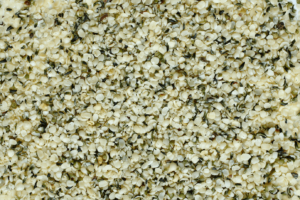Lipid profile of hempseeds
The oil fraction of hempseeds is highlighted for its enormous proportion of non-saturated fatty acids (90%) and its high level of essential fatty acids, with a very optimum balance between them (figure 1) (Leonard et al. 2019; Farinon et al. 2020).
The only fatty acids that are considered essential for human beings are the 𝛼-Linoleic Acid (ALA) and the Linoleic Acid (LA), from the omega-3 and omega-6 family respectively. Being essential means that our organism cannot synthesize them, therefore, they have to be consumed obligatorily in the diet. The lack or deficit of these essential fatty acids in the diet can cause serious metabolic alterations.

According to the current dietary recommendations, essential fatty acids should be consumed in an adequate proportion, ideally in a relation 4:1 of omega-6: omega-3, until a maximum of 10:1 (Simopoulos, 2002; Gómez-Candela et al. 2011). 2011).
Somestudies show that even if there is evidence that keeping the proportion omega-3: omega-3 is important- especially under certain health circumstances-, what is really important is to keep a high intake of omega-3, even if the omega-6 is also high.

Hempseed oil has on average a 3:1 relation, which is only exceeded by the linseed oil (1:4). Olive oil has a relation 10:1 of omega 6: omega-3 (Figure 1).
These fatty oils and their intake in a correct proportion have been widely investigated for their antiinflammatory properties and their possible protective effects against hearth diseases, obesity, diabetes, inflammatory diseases, autoimmune diseases, and cancer (Sokoła-Wysoczańska et al., 2018; Simopoulos, 2002).

Furthermore, hempseed oil has 𝛾-linolenic acid (GLA), a long chain omega-6 fatty acid, which has high nutritional and metabolic importance. Kapoor and Huang (2006) describe the role of GLA in the regulation of inflammatory responses, acting as a biosynthetic precursor of the synthesis of anti-inflammatory eicosanoids.
Other important data is that the synthesis of this long chain fatty acid could be insufficient under some biological states as fetal development or breastfeeding. This is because the immature organism of the fetus and of the new born cannot synthesize it at a sufficient pace; therefore, they have to take it from their mother. Mothers can see their need to ingest essential fatty acids increased, and/or their correspondent derived long chain fatty acids, as GLA,, during those periods (Gómez Candela et al. 2011).

Finally, there is a scientific consensus regarding the idea that decreasing the ingest of saturated fats is beneficial for health (Kennedy et al. 2009). In comparison with other vegetable oils, hempseed oil has the highest proportion of polyunsaturated fatty acids (PUFA; Callaway, 2004; Leson, 2005). A reduction in the risk of heart diseases, cancer, rheumatoid arthritis, hypertension, inflammatory and autoimmune illnesses has been related to a higher ingest of PUFA (Abedi & Sahari, 2014).

Figure 1.
Hempseed fatty acid composition compared to other vegetable oils. Orderly, from left to right: almond, hazelnut, nut, hemp, linen, canola, soy, sunflower, and olive oils. Figure taken from Callaway, 2004 and Leson, 2005.
References
Abedi, E., & Sahari, M. A. (2014). Long-chain polyunsaturated fatty acid sources and evaluation of their nutritional and functional properties. Food science & nutrition, 2(5), 443–463. https://doi.org/10.1002/fsn3.121
Callaway JC. Hempseed as a nutritional resource: an overview. Euphytica: Netherlands Journal of Plant Breeding. 2004 ;140(1-2):65-72. DOI: 10.1007/s10681-004-4811-6.
Farinon B, Molinari R, Costantini L, Merendino N. The seed of industrial hemp (Cannabis sativa L.): Nutritional Quality and Potential Functionality for Human Health and Nutrition. Nutrients. 2020 Jun 29;12(7):1935. doi: 10.3390/nu12071935. PMID: 32610691; PMCID: PMC7400098.
Gómez-Candela, Carmen; Bermejo López, Laura M.; Loria-Kohen, Viviana. Importance of a balanced omega 6/omega 3 ratio for the maintenance of health. Nutritional recommendations. Nutrición Hospitalaria 26.2 (2011): 323-329
Kapoor R, Huang YS. Gamma linolenic acid: an antiinflammatory omega-6 fatty acid. Curr Pharm Biotechnol. 2006 Dec;7(6):531-4. doi: 10.2174/138920106779116874. PMID: 17168669.
Kennedy A, Martinez K, Chuang CC, LaPoint K, McIntosh M. Saturated fatty acid-mediated inflammation and insulin resistance in adipose tissue: mechanisms of action and implications. J Nutr. 2009 Jan;139(1):1-4. doi: 10.3945/jn.108.098269. Epub 2008 Dec 3. PMID: 19056664.
Leonard W, Zhang P, Ying D, Fang Z. Hempseed in food industry: Nutritional value, health benefits, and industrial applications. Compr Rev Food Sci Food Saf. 2020 Jan;19(1):282-308. doi: 10.1111/1541-4337.12517. Epub 2019 Dec 19. PMID: 33319519.
Leson, Gero. 2005. Hemp Seeds for Nutrition. Article from the European Industrial Hemp Association (EIHA) webpage. https://eiha.org/media/attach/83/hemp_seeds_for_nutrition.pdf
Simopoulos AP. Omega-3 fatty acids in inflammation and autoimmune diseases. J Am Coll Nutr. 2002 Dec;21(6):495-505. doi: 10.1080/07315724.2002.10719248. PMID: 12480795.
Sokoła-Wysoczańska E, Wysoczański T, Wagner J, Czyż K, Bodkowski R, Lochyński S, Patkowska-Sokoła B. Polyunsaturated Fatty Acids and Their Potential Therapeutic Role in Cardiovascular System Disorders-A Review. Nutrients. 2018 Oct 21;10(10):1561. doi: 10.3390/nu10101561. PMID: 30347877; PMCID: PMC6213446.



